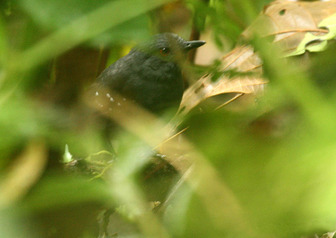Esmeraldas Antbird
The Esmeraldas Antbird is a species of bird in the Thamnophilidae family. It is found in Colombia and Ecuador. The species has been the source of taxonomic confusion in the past, as the male was placed as a separate species . It is only recently that the male and female were realised to be the same species.

Original source: Michael WoodruffPermission(Reusing this file)This image, which was originally posted to Flickr.com, was uploaded to Commons using Flickr upload bot on 01:44, 13 November 2008 (UTC) by Snowmanradio (talk). On that date it was licensed under the license below. This file is licensed under the Creative Commons Attribution-Share Alike 2.0 Generic license.You are free:to share – to copy, distribute and transmit the work
Author: Michael WoodruffPermission(Reusing this file)This image, which was originally posted to Flickr.com, was uploaded to Commons using Flickr upload bot on 01:44, 13 November 2008 (UTC) by Snowmanradio (talk). On that date it was licensed under the license below. This file is licensed under the Creative Commons Attribution-Share Alike 2.0 Generic license.You are free:to share – to copy, distribute and transmit the work
The Esmeraldas Antbird is classified as Least Concern. Does not qualify for a more at risk category. Widespread and abundant taxa are included in this category.
The Esmeraldas Antbird (Myrmeciza nigricauda) is a species of bird in the Thamnophilidae family. It is found in Colombia and Ecuador. The species has been the source of taxonomic confusion in the past, as the male was placed as a separate species (and in another genus, Sipia). It is only recently that the male and female were realised to be the same species. Its natural habitats are subtropical or tropical moist lowland forests and subtropical or tropical moist montanes. More
Esmeraldas Antbird The Esmeraldas Antbird (Myrmeciza nigricauda) is a species of bird in the Thamnophilidae family. It is found in Colombia and Ecuador.Its natural habitats are subtropical or tropical moist lowland forests and subtropical or tropical moist montanes. See more at Wikipedia.org... More
The Esmeraldas Antbird (Myrmeciza nigricauda) is a species of bird in the Thamnophilidae family. Osbert Salvin ( February 25, 1835 - June 1, 1898) was an English naturalist. Frederick DuCane Godman DCL FRS FLS FGS FRGS FES FZS MRI FRHS Birds ( class Aves) are bipedal endothermic ( Warm-blooded) Vertebrate animals that lay eggs. The antbirds are a large family, Thamnophilidae, of Passerine Birds found across subtropical and tropical Central and South America It is found in Colombia and Ecuador. More
Esmeraldas Antbird, in addition to a female Chestnut-backed Antbird too. Brownish Twistwing and Thrush-like Schiffornis gave us some good looks, as did a number of Gray-backed Hawks (a restricted range raptor species that is easy to see around this foothill reserve).Other morning highlights included a male Western Slaty-antshrike, a pair of calling Chestnut-mandibled Toucans, a couple of Slaty Antwrens working their way through the understorey, and the often-skulking Whiskered and Bay Wrens both being seen. More
Family : Thamnophilidae
Genus : Myrmeciza
Species : nigricauda
Authority : Salvin & Godman, 1892
